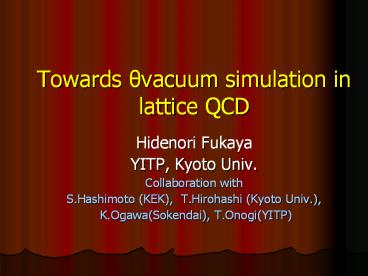Towards ?vacuum simulation in lattice QCD - PowerPoint PPT Presentation
Title:
Towards ?vacuum simulation in lattice QCD
Description:
Towards vacuum simulation in lattice QCD Hidenori Fukaya YITP, Kyoto Univ. Collaboration with S.Hashimoto (KEK), T.Hirohashi (Kyoto Univ.), K.Ogawa(Sokendai), T ... – PowerPoint PPT presentation
Number of Views:91
Avg rating:3.0/5.0
Title: Towards ?vacuum simulation in lattice QCD
1
Towards ?vacuum simulation in lattice QCD
- Hidenori Fukaya
- YITP, Kyoto Univ.
- Collaboration with
- S.Hashimoto (KEK), T.Hirohashi (Kyoto Univ.),
- K.Ogawa(Sokendai), T.Onogi(YITP)
2
Contents
- Introduction
- ? vacuum simulation of 2D QED
- How to fix topology in 4D QCD
- Tempering for QCD ? vacuum
- Conclusion
3
1. Introduction
- Chiral symmetry and topology are very
- important and related each other...
- Chiral symmetry breaking
- Anomaly
- Construction of chiral gauge theory
- 4D N1 SUSY (Chiral super fields)
- Our aim is to keep chiral symmetry and
- topological properties in 4D lattice QCD.
- ? ? vacuum simulation
4
1. Introduction
- Ginsparg-Wilson relation
- ? exact chiral symmetry at classical level.
- Luschers admissibility condition
- ? locality of Dirac operator
- ? Stability of the index (topological charge)
Phys.Rev.D25,2649(82)
Phys.Lett.B428,342(98),Nucl.Phys.B549,295(99)
5
1. Introduction
- Our goal is to calculate path integrals with
?term
6
2. ?vacuum simulation of 2D QED
- The 2-flavor massive Schwinger model
- We have a geometrical definition of the
topological charge
7
2. ?vacuum simulation of 2D QED
- We also developed a method to calculate
- Classical solution ? Constant field
strength. - Moduli (constant potential which affects Polyakov
loops ) integral of the determinants - ? Householder and QL method.
- Integral of
- ? fitting with polynomiyals.
8
2. ?vacuum simulation of 2D QED
- Thus, we could evaluate
- by Luschers gauge action and our reweighting
method and the results were consistent with the
continuum theory.
..
Details are shown in HF,T.Onogi,Phys.Rev.D68,0
74503(2003).
9
2. ?vacuum simulation of 2D QED
- For example, we calculated the pseudoscalar
- condensates,
- which can be obtained from the anomaly equation,
10
2. ?vacuum simulation of 2D QED
- We evaluate the total expectation value in
- ?vacuum
Details are in HF,T.Onogi, Phys.Rev.D70,054508(200
4).
11
3. How to fix topology in 4D QCD
- Also in 4D QCD, we expect that can
be obtained with the action - but
- No geometrical (and practical ) definition of Q.
- The index of D ? a lot of computational costs.
12
3. How to fix topology in 4D QCD
- (New) Cooling method
- We cool the configuration smoothly by
performing the hybrid Monre Carlo steps with - decreasing g2 (admissibility is always
satisfied.). - ? We obtain a cooled configuration
- close to the classical background at
- very weak g20.0001 then,
- gives an integer with 10 accuracy.
13
3. How to fix topology in 4D QCD
- How can e be determined ?
- The stability of Q is proved only when
- elt emax 1/20.49 .
- ? configuration space is too narrow
- on 104204 lattice.
Let us search the parameters ß, e, V, ?t which
can fix Q. Anothor group is also studying this
action. S.Shcheredin, W.Bietenholz, K.Jansen,
K.I.Nagai, S.Necco and L.Scorzato,
hep-lat/0409073
14
3. How to fix topology in 4D QCD
- Action Luscher action (quenched)
- Algorithm The hybrid Monte Carlo method.
- Gauge coupling ß (6/g2) 1.0 2.8
- Lattice size 104,144,164
- Admissibility condition 1/e 2/3 1.0
- Topological charge Q - 3 3
- 10 40 molecular dynamics steps with the step
- size ?t 0.001-0.02 in one trajectory.
- Numerical simulations
..
The simulations were done on the Alpha work
station at YITP and SX-5 at RCNP.
15
3. How to fix topology in 4D QCD
- Initial configuration
- For topologically non-trivial initial
configuration, - we use a discretized version of instanton
- solution on 4D torus
- which gives constant field strength with
- topological charge Q.
A.Gonzalez-Arroyo,hep-th/9807108,
M.Hamanaka,H.Kajiura,Phys.Lett.B551,360(03)
16
3. How to fix topology in 4D QCD
- Results
17
3. How to fix topology in 4D QCD
- Physical scale of the lattice
Both 1/e1.0, ß?1.4 and 1/e2/3, ß?2.6 are
corresponding ß?6.0 (1/a 2.0 GeV) for plaquette
action. ? Q can be fixed on lattices finer than
(2.0GeV)-1.
18
4. Tempering for QCD ?vacuum
Our method to calculate the partition function
used in 2D QED is not applicable to 4D QCD
due to its large numerical costs.
19
4. Tempering for QCD ?vacuum
- Tempering method
- Let us extend the configuration space
Q is not conserved.
? N0,
? N1,
? N-1, samples,
If we obtain
20
4. Tempering for QCD ?vacuum
- There are several tempering methods...
- Simulated tempering G.Parisi et
al,Europhys.Lett.19,451(92) - Parallel tempering E.Marianari et
al,cond-mat/9612010, - K.Hukushima et al, cond-mat/9512035
- If the tempering is applicable for Luscher
- action, we may able to treat ?vacuum,
21
5. Conclusion
- We find at V104 , 144 ,
- Well- controlled topological charge can be
measured - by our cooling method .
- Q can be fixed for more than 2000 trajectory
- length (200 uncorrelated samples .) if the
lattice is - fine enough (1/a 2.0GeV) even when we set
- 1/e2/3.
- Next we will try
- more quantitative studies
- large volume
- The index of GW fermion
- tempering for ?vacuum
- full QCD
22
6. Outlook
- Luschers admissibility condition will be
- important for
- Locality of Dirac operators
- e-regime
- Finite temperatures and Chiral transition
- SUSY
- Majorana fermions?
- Non commutative lattice ??
- Matrix model ???































